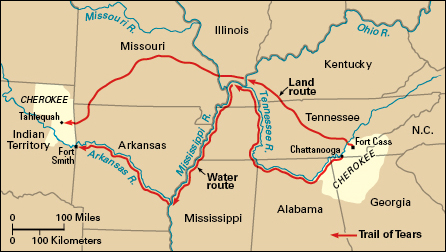Indian Removal Act of 1830 was a United States law that authorized the president to negotiate with Indigenous (native) groups to exchange their homelands east of the Mississippi River for federal land in the West. The act provided funding for the relocation of these tribes. By the end of the 1830’s, nearly all Indigenous people in the East had been relocated to the Indian Territory, which occupied most of present-day Oklahoma.

Background.
Andrew Jackson took office as president of the United States in 1829. A long-time soldier, Jackson had fought wars against the Creek and Seminole. He believed that white and Indigenous people could not coexist peacefully. Early in his presidency, Jackson supported the rights of such states as Georgia, Alabama, and Mississippi to seize territory occupied by Indigenous people.
The Indian Removal Act.
Jackson’s allies in Congress introduced legislation providing for “an exchange of lands with the Indians residing in any of the states or territories, and for their removal west of the river Mississippi.” The measure authorized the president to negotiate relocation treaties with Indigenous groups living east of the river. It allowed for the designation of previously unorganized western lands as districts for “Indian removal” and guaranteed United States protection for the tribes in their new homes. Jackson signed the bill into law on May 28, 1830.
Jackson argued in favor of his policy in a December 1830 address before Congress: “It will separate the Indians from immediate contact with settlements of whites; free them from the power of the States; enable them to pursue happiness in their own way and under their own rude institutions; will retard the progress of decay, which is lessening their numbers, and perhaps cause them gradually, under the protection of the Government and through the influence of good counsels, to cast off their savage habits and become an interesting, civilized, and Christian community.”
Effects of the law.
By the late 1830’s, almost all the Indigenous peoples of the Southeast had signed treaties to move west of the Mississippi. Under the terms of the Indian Removal Act, the land exchanges were to be on a voluntary basis. In practice, however, most of the Indigenous people were eventually forced from their lands due to fraudulent practices, fear of violence, or military action. Thousands died during their journeys to the Indian Territory.

